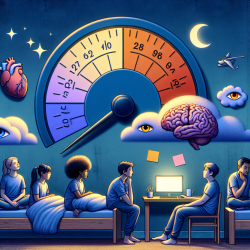Introduction
In the realm of pediatric speech-language pathology, ensuring optimal outcomes for children is paramount. The recent study titled "Comorbidities Confounding the Outcomes of Surgery for Third Window Syndrome: Outlier Analysis" provides valuable insights into how comorbidities can impact surgical outcomes. This blog aims to highlight the key findings from this research and offer guidance on how practitioners can use these insights to improve their clinical practice.
Understanding Third Window Syndrome
Third Window Syndrome (TWS) is a condition characterized by a dehiscence or thinning of the bone overlying the semicircular canals, leading to vestibular and auditory symptoms. The study in question focused on patients with Superior Semicircular Canal Dehiscence (SSCD) who underwent surgery but did not achieve the expected outcomes. By analyzing these outlier cases, the researchers identified comorbidities that could have confounded the surgical results.
Key Findings from the Study
The study employed a comprehensive observational analytic case-control design, examining twelve adult patients with SSCD symptoms. Despite surgical intervention, these patients continued to experience symptoms, prompting a deeper investigation into potential comorbidities. The findings revealed a high prevalence of psychological comorbidities, such as depression and anxiety, among the outlier cohort. Additionally, traumatic brain injuries were identified as a significant confounding factor.
Implications for Practitioners
For practitioners in the field of speech-language pathology, these findings underscore the importance of considering comorbidities when evaluating treatment outcomes. Here are some practical steps practitioners can take:
- Comprehensive Assessment: Incorporate screening tools such as the Millon Behavioral Medicine Diagnostic, PHQ-9, and GAD-7 to identify psychological comorbidities preoperatively.
- Multidisciplinary Approach: Collaborate with neurologists, psychologists, and other specialists to ensure a holistic evaluation of the patient's condition.
- Tailored Intervention Plans: Develop individualized treatment plans that address both the primary condition and any identified comorbidities.
- Ongoing Monitoring: Regularly assess the patient's progress and adjust treatment strategies as needed to accommodate any changes in their condition.
Encouraging Further Research
The study's findings highlight the need for further research into the impact of comorbidities on surgical outcomes for TWS. Practitioners are encouraged to contribute to this growing body of knowledge by documenting and sharing their clinical experiences. Collaborative research efforts can lead to the development of more effective treatment protocols and improved outcomes for children with TWS.
Conclusion
By understanding and addressing comorbidities, practitioners can enhance the effectiveness of surgical interventions for Third Window Syndrome. This data-driven approach not only improves patient outcomes but also contributes to the advancement of clinical practice in speech-language pathology. To read the original research paper, please follow this link: Comorbidities confounding the outcomes of surgery for third window syndrome: Outlier analysis.










